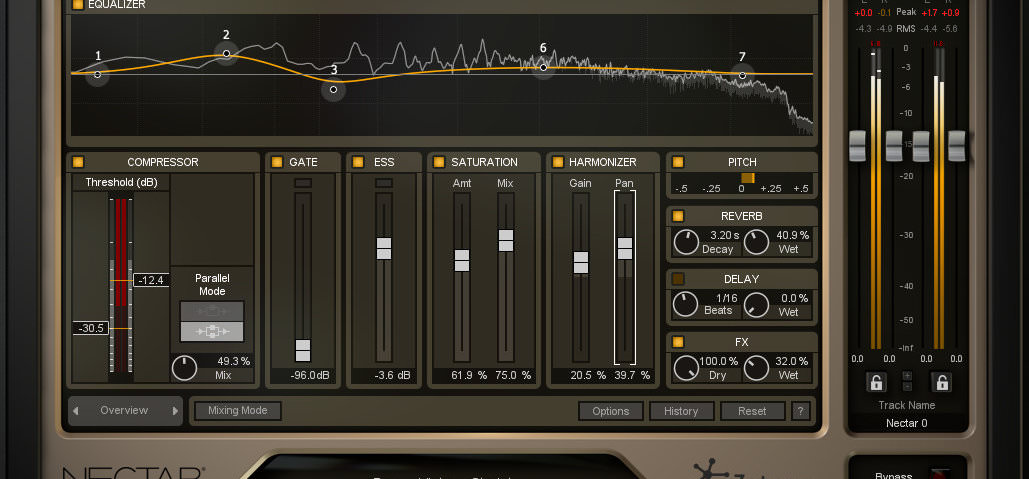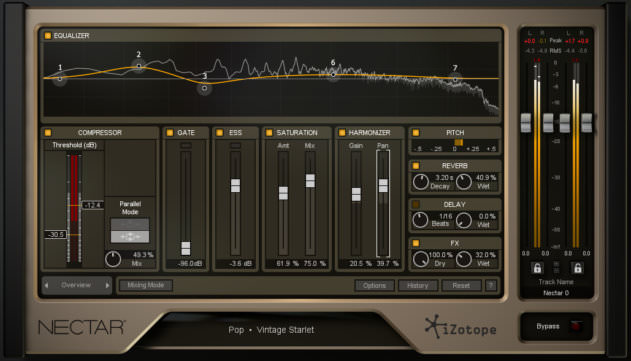Offering a total of 11 vocal processors including compression, EQ and reverb, Nectar 2 promises a lot for one plugin. David Felton puts the latest incarnation of iZotope’s one-stop vocal solution to the test.
The trend towards all-in-ones – plugins that do a bit of everything – has been gathering pace in recent years. Whether that’s part of an innate societal drive towards simplicity (the Waves OneKnob series
representing the logical end point) or the twin trend to make usage-specific plugins, iZotope’s Nectar 2 does a bit of both.
Marketed as a vocal production all-in-one, Nectar offers all the tools that the vocal producer would typically call upon, from compressor and gate to EQ and de-esser. Reverb and delay take care of ambient processing. More esoteric tools for less regular treatment include a powerful harmoniser, saturation and a range of lo-fi and modulation effects. (A Production Suite bundle is also available for an additional $70, adding Pitch Editor and Breath Control plugins to the package.)
Take 1
Download and installation is swift and intuitive. The free trial edition is a simple download and launches with the options to purchase the full product or use the demo for ten days. Looks are, in typical iZotope fashion, clean and classy – elegant greys and tan with key information in orange. The GUI does an excellent job of keeping key information, from EQ to compression levels, on the main panel. Toggling away from Overview to Advanced mode gives you an insight into the power beneath the bodywork, with each of the modules given its own page in which the apparently simple options on the Overview panel can be tweaked, sometimes to extraordinary detail.
Looks are, in typical iZotope fashion, clean and classy
Interaction with the GUI is nice; real-time visual feedback on everything from frequency information in the EQ section to gain reduction in the compressor helps refine settings. The real-time gain reduction chart, overlaid on the treated audio’s waveform, is a very nice touch indeed. Elsewhere, the click and drag functionality allows swift manipulation of the EQ settings, making frequency manipulation easy.
Classic inspiration
The analogue factor is a key part of the sales drive of Nectar 2. The marketing material is laden with references to ‘classic’, ‘analogue’ and ‘retro’. Motown is the inspiration behind the twin analogue-modelled compressors and the EMT 140 plate
gets a namedrop as the model for the redesigned reverb unit. With producers across the board looking to the sounds of yesterday for inspiration, the move makes sense. But it’s not all retro. The option to create distinctly 21st-century auto-tuned effects demonstrates iZotope’s decision to blend the best of the past with the vocal producer’s needs of today.
A case in point is the EQ. Here, the restrictive models of the past are eschewed in favour of a hugely versatile 5-band EQ. Each band can be set to a range of filters: low shelf, high shelf, low-pass, high-pass or Baxandall
. These can then be further shaped with, yes, you guessed it, Analog or Vintage options. It’s certainly a powerful section of the plugin, allowing the generation of highly flexible curves to shape any vocal.
The compressor offers four models: Digital, Vintage, Optical and Solid State. When launched in Advanced mode, you can shape the sound in the ways you would expect, with both peak and RMS settings on offer as well as a parallel mode that splits the signal and feeds each part to a different compressor. In both cases, the wet/dry balance can be set to allow for parallel processing anyway. iZotope offers excellent compression tools in Ozone and the same is true here, the plugin doing anything from gentle taming to ruthless dynamics-bashing with ease and, where you want, a sheen of old-school character.
Of particular note to electronic music producers is the Saturation unit which offers five flavours of analogue-style warmth, from Tape mode to Tube to just, um, Warmth. Sometimes just adding 20% or so saturation can be enough to give a vocal a little low and mid girth; more can bring serious clout to an already ballsy vocal. Although the exact differences between Analog and Warm aren’t hugely noticeable, each is worth an audition.
The Saturation unit offers five flavours of analogue-style warmth, from Tape mode to Tube to just, um, Warmth.
Space
Ambient effects are taken care of with a dedicated reverb and delay unit. The reverb – a weak link in the original version of Nectar – has been given a radical overhaul, although it’s still not perfect. Where the plugin offers various flavours for other key functions, it seems a little strange to confine users to plate-style reverb – where are the room and halls? And though no one would deny the evergreen utility of plate treatments on a range of vocals, it seems a slightly odd limitation. Furthermore, the decay times, true to the original EMT plate, only stretch as long as 5 seconds and as low as 1. Still, it’s a solid recreation of the 140, nearly standing up to the officially licensed UAD version, and the addition of saturation and width alongside low- and high-cut filters certainly give the producer enough tools to shape the reverb to fit the track and the voice.
By contrast, the delay unit offers considerably more choice. Digital, Tape and Analogue settings bestow varying levels of warmth to the signal, with controls over everything from delay time and feedback to stereo width and the lo-fi Trash setting. A modulation panel offers enough control for tape-style wow and flutter.
A notable mention should go to the de-esser, which has just two settings – a central frequency and a slider that reduces sibilant frequencies. De-essers can be hugely hit and miss, but the algorithms employed here – apparently based on the DBX 902 – do an amazingly intuitive job across a range of different sound sources. Nectar certainly holds its own against dedicated units like my usual go-to tool, the UAD Precision De-Esser.


07.27 PM
“And while it’s unlikely that the seasoned vocal producer would jettison their well-worn copies of Meldoyne or their favourite EQs and compressors for this all-in-one,…”
yea, exactly why it should be marketed to the Garageband market.:
11.51 AM
@homeinametronome: nice bit of snobbery there. I use the producer version of Nectar, along with “well worn” copies of my favourite software: sometimes you want to know if something will work “as is” and Nectar will give you the answer faster than anything else I know of. As to Garageband, Rhianna’s Umbrella uses a Garage band loop, so perhaps the Garageband market is bigger and richer than you think.
01.18 AM
Melodyne + Nectar2 = Amazing
07.06 PM
I don’t think it was intended to be snobbish. But there’s always going to be people who take things the wrong way.
07.07 PM
When he said “it’s unlikely that a seasoned vocal producer would jettison….”, he meant it’s unlikely they would stop using their old stuff. He didn’t mean it wouldn’t be used some of the time, as part of a range of tools.